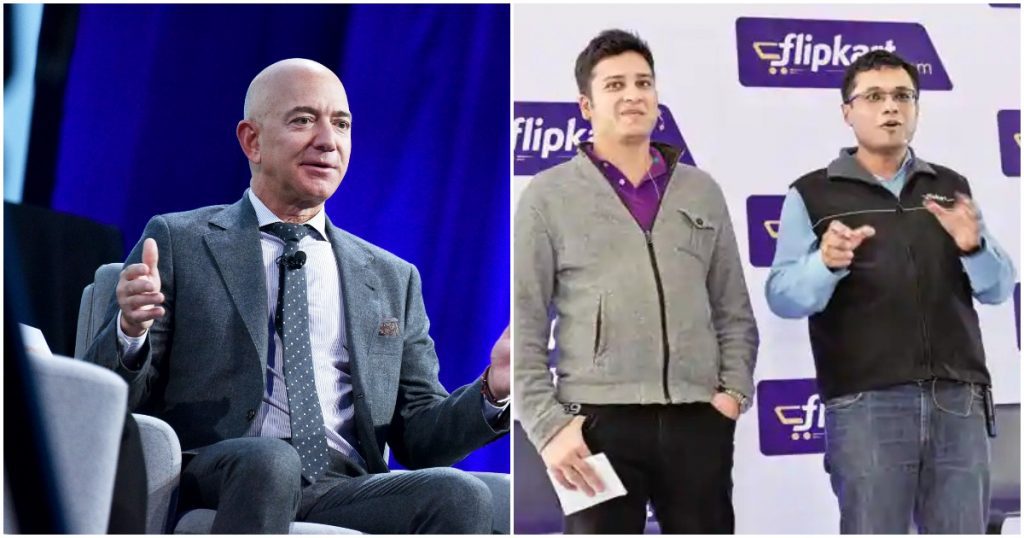Flipkart and Amazon might be currently slugging it out to become India’s top e-commerce company, but had things gone a little differently, Amazon could’ve acquired Flipkart three years ago.
Amazon had held advanced talks to acquire Flipkart in 2017, a new book has revealed. Amazon Unbound, written by Brad Stone, details how Amazon CEO Jeff Bezos and Flipkart Group Chairperson Sachin Bansal had met several times to discuss an acquisition. Things, of course, turned out differently, and Flipkart ended up being sold to Walmart in 2018.

In 2017, Flipkart and Amazon were battling for the top spot in India’s e-commerce race, and both were bleeding large sums of money. Both companies were also facing regulatory challenges, with new laws requiring that no single seller could account for more than 25% of sales on their platforms, which impacted Amazon’s Cloudtail and Flipkart’s WS Retail. At this point, the two companies had explored an acquisition.
“Sachin Bansal met Jeff Bezos at The Weekend, an elite conference in Aspen, Colorado, organized by Ari Emanuel, CEO of the entertainment and media agency Endeavor, and Google chairman Eric Schmidt,” Brad Stone writes. “He pitched an acquisition that would end the capital-intensive conflict between the two companies but keep both websites independent. Amazon.in would broker everyday items like groceries and books, while Flipkart would sell higher-value products, giving it additional leverage to reach better deals with vendors like smartphone makers,” the book reveals.
Sachin Bansal was personally interested in the acquisition too — after a series of bets which didn’t quite pay off, such as making Flipkart app-only, he’d been asked to step aside as Flipkart’s CEO, and the role had been given to co-founder Binny Bansal. Sachin Bansal hoped that with Amazon at the helm, he’d be able to get back the top role.
Bezos was intrigued by Sachin Bansal’s acquisition offer, and asked his team to study details. When negotiations began, Amazon quoted a price based on data that showed that Amazon had already grown bigger than Flipkart in India. Flipkart, however, disagreed with those numbers, insisting that it was bigger. With both companies unable to even decide on market data, the negotiations didn’t go too far.
Around the same time, Walmart approached the Flipkart board, and the two sides discussed an acquisition. Flipkart’s board was now split among three choices — pursuing the acquisition with Amazon, pursuing an acquisition with Walmart, and remaining independent.
Masayoshi Son, whose company Softbank was one of the biggest investors in Flipkart at the time, was reportedly extremely keen that Flipkart be sold to Amazon, hoping to become a global ally of Jeff Bezos. Sachin Bansal too favoured a deal with Amazon, hoping he’d once again get to be Flipkart CEO. But the rest of Flipkart’s board took a dim view of the idea — they felt that India’s regulators wouldn’t allow the two biggest e-commerce companies in the country to come together and create a monopoly.
Amidst this, Bezos wanted to meet with Flipkart again. In March 2018, Sachin Bansal and Kalyan Krishnamurthy flew to the US and met Jeff Bezos in the boathouse behind his home on Lake Washington. A few weeks later, Bezos also spoke with two of Flipkart’s biggest investors, Tiger Global’s Lee Fixel and Masayoshi Son.
But even as the two sides negotiated, they couldn’t see eye to eye on thorny issue — a breakup fee. Flipkart wanted a $4 billion “break-up fee” in case the two companies agreed with the deal, but the deal was later scuttled by regulators, or couldn’t take place within 18 months. Amazon was unwilling to sign such a deal — it would’ve meant that it it would’ve gifted $4 billion to its biggest Indian competitor in case the deal couldn’t go through. Talks between the two parties, then, fell apart.
Walmart, though, was waiting in the wings. The company quietly built a rapport with the Flipkart team, and told them that could operate relatively independently after the acquisition. Flipkart’s board finally agreed, and decided to sell the company to Flipkart.
But Sachin Bansal wasn’t happy — he wanted Walmart to guarantee him future control of management of Flipkart. The board, though, had had enough at this point, and asked him to leave. Sachin Bansal quit the company on 8th May 2018. The next day, Walmart announced that it had acquired a 77 percent stake in Flipkart for $16 billion (Rs. 1.12 lakh crore).
Cut to three years later, and Flipkart and Amazon have continued their rivalry. India’s e-commerce space has grown, and both companies are still slugging it out as before. They, interestingly, still can’t agree on who’s bigger.